
Leucopogon plumuliflorus is a species of flowering plant in the heath family Ericaceae and is endemic to the south-west of Western Australia. It is a weakly erect shrub with egg-shaped leaves and spikes of white or pinkish-white, tube-shaped flowers.
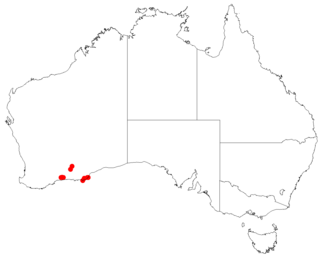
Leucopogon bossiaea is a species of flowering plant in the heath family Ericaceae and is endemic to a restricted area in the south-west of Western Australia. It is an erect shrub with elliptic to broadly egg-shaped leaves and white flowers in four to eleven upper leaf axils.

Styphelia cordifolia, commonly known as heart-leaved beard-heath, is a species of flowering plant in the heath family Ericaceae and is endemic to Australia. It is an erect shrub with broadly egg-shaped to round leaves, and white, tube-shaped flowers, the petals bearded on the inside.

Styphelia allittii is a species of flowering plant in the family Ericaceae and is endemic to the south-west of Western Australia. It is a rigid, glabrous shrub that typically grows to a height of about 30 cm (12 in) and has egg-shaped or lance-shaped leaves and tube-shaped, white flowers.

Styphelia breviflora is a species of flowering plant in the heath family Ericaceae and is endemic to the south-west of Western Australia. It is an erect, spindly, glabrous shrub that typically grows to a height of up to about 1.5 m. It has oblong to lance-shaped or linear leaves 4–9 mm (0.16–0.35 in) long on a short petiole and with a small, rigid point on the tip. The flowers are borne singly or in pairs in leaf axils on a short peduncle with small bracts and bracteoles about half as long as the sepals. The sepals are about 2 mm (0.079 in) long and the petals white and about 4 mm (0.16 in) long, the petal lobes longer than the petal tube.
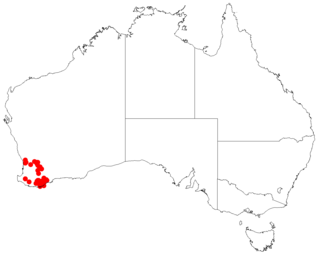
Styphelia cymbiformis is a flowering plant in the family Ericaceae and is endemic to the south-west of Western Australia. It is a bushy or wiry shrub that typically grows to a height of 30–50 cm (12–20 in) and has more or less glabrous branches. Its leaves are erect, linear to lance-shaped and sharply-pointed, mostly 2–4 mm (0.079–0.157 in) long. The flowers are arranged in short spikes, sometimes of only two or three flowers, with lance-shaped, leaf-like bracts, and bracteoles half as long as the sepals at the base of the spikes. The sepals are 2.5–3.0 mm (0.098–0.118 in) long and the petals slightly longer than the sepals, the lobes shorter than the petal tube.

Leucopogon fimbriatus is a species of flowering plant in the heath family Ericaceae and is endemic to the south-west of Western Australia. It is a bushy, erect or sprawling shrub with overlapping egg-shaped or oblong leaves and spikes of tube-shaped white flowers on the ends of branches.

Styphelia flavescens is a species of flowering plant in the heath family Ericaceae and is endemic to the south-west of Western Australia. It is a shrub with oblong leaves and white, tube-shaped flowers that are densely bearded on the inside.

Leucopogon opponens is a species of flowering plant in the heath family Ericaceae and is endemic to the south-west of Western Australia. It is an erect, slender shrub with its leaves arranged in opposite pairs, and white, tube-shaped flowers.
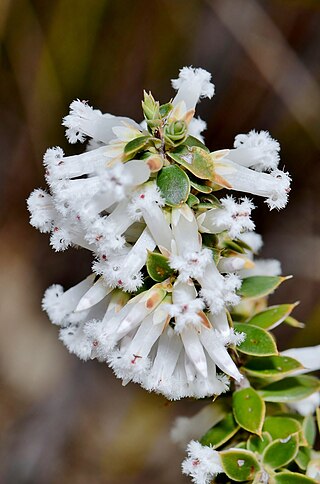
Styphelia erubescens is a species of flowering plant in the heath family Ericaceae and is endemic to the south-west of Western Australia. It is an erect shrub with variably-shaped leaves with a small, sharp point on the tip, and white, pink or red, tube-shaped flowers.
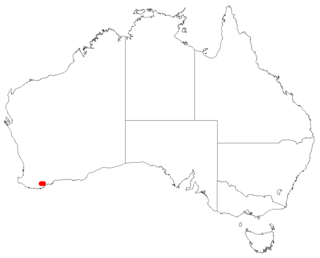
Styphelia psilopus is a species of flowering plant in the heath family Ericaceae and is endemic to the Stirling Range in the south-west of Western Australia. The species was first formally described in 1859 by Sergei Sergeyevich Sheglejev who gave it the name Leucopogon psilopus in the Bulletin de la Société impériale des naturalistes de Moscou, from specimens collected by James Drummond. In 2020, Michael Hislop, Darren Crayn and Caroline Puente-Lelievre transferred the species to Styphelia as S. psilopus in Australian Systematic Botany. The specific epithet (psilopus) means "glabrous foot". It is listed as "Priority Two" by the Western Australian Government Department of Biodiversity, Conservation and Attractions, meaning that it is poorly known and from only one or a few locations.

Styphelia racemulosa is a species of flowering plant in the heath family Ericaceae and is endemic to the south-west of Western Australia. It is an erect, rigid shrub with linear leaves and white, tube-shaped flowers usually arranged in pairs or threes in leaf axils.

Styphelia strongylophylla is a species of flowering plant in the heath family Ericaceae and is endemic to the southwest of Western Australia. It is an erect shrub with crowded egg-shaped or round leaves and white, tube-shaped flower arranged singly or in pairs in leaf axils.
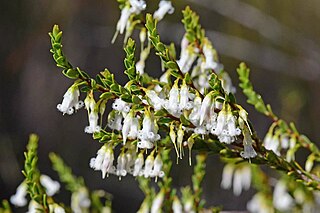
Styphelia woodsii, commonly known as nodding beard-heath, is a species of flowering plant in the heath family Ericaceae and is endemic to southern continental Australia. It is a slender shrub with more or less erect, egg-shaped leaves, and pendent white, tube-shaped flowers with densely bearded lobes.
Styphelia exserta is a species of flowering plant in the heath family Ericaceae and is endemic to the south-west of Western Australia. It is an erect shrub with broadly egg-shaped leaves, and white, tube-shaped flowers.

Styphelia hainesii is a species of flowering plant in the heath family Ericaceae and is endemic to the south coast of Western Australia. It is a bushy shrub with egg-shaped leaves, the narrower end towards the base, and red, tube-shaped flowers arranged singly in leaf axils.
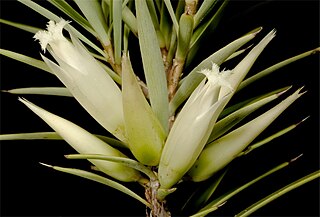
Styphelia macrocalyx, commonly known as Swan berry, is a species of flowering plant in the heath family Ericaceae and is endemic to the south west of Western Australia. It is a shrub with sharply pointed, narrowly lance-shaped leaves and white, tube-shaped flowers with tufts of hairs on the inside.
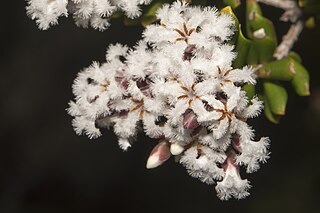
Styphelia melaleucoides is a species of flowering plant in the heath family Ericaceae and is endemic to the south west of Western Australia. It is an upright, spreading shrub with egg-shaped to almost round leaves and white, tube-shaped flowers bearded inside.

Lissanthe pluriloculata is a species of flowering plant in the family Ericaceae and is endemic to Queensland. It is a small, bushy shrub with sharply-pointed linear leaves and spikes or racemes of tube-shaped, white flowers.
Styphelia subulata is a species of flowering plant in the heath family Ericaceae and is endemic to the south-west of Western Australia. It is a rigid shrub with many branches, usually sharply-pointed, linear leaves and usually one or two white, tube-shaped flowers in leaf axils.



















